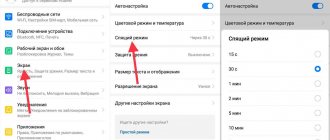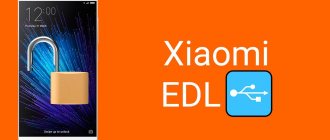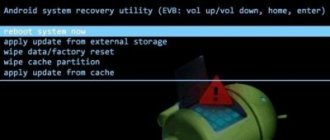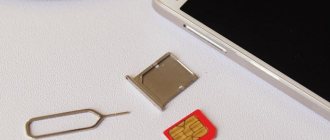Most manufacturers of smartphones and tablets now block the bootloader of the device, this is done in order to avoid installing custom firmware and strengthening security.
Xiaomi has also been no exception in recent years and also blocks the bootloader on its smartphones, as a result of which users painfully unlock it in order to install the latest firmware or install root rights.
Xiaomi devices have a special EDL mode with which you can flash even with a locked bootloader.
How to put Xiaomi into EDL mode, read further in this article!
Putting Xiaomi into EDL mode
At the moment, there are two options for transferring Xiaomi to special. firmware mode. Let's look at each of them.
Option 1
- All Xiaomi drivers must be installed on your computer
- Fastboot utility or ADB RUN program
- Put Xiaomi into Fastboot/Bootloader mode
- Connect your smartphone to your computer
- In Fastboot enter the following command: fastboot oem edl
- The screen on your device will turn black
- Xiaomi in EDL mode
Option 2
- Turn off your Xiaomi device
- Press and hold the “ON/OFF” and “Volume +” buttons at the same time
- After vibration, release the “ON/OFF” button, but continue to hold the “Volume +” button
- Hold the button until the menu appears
- Click the download button
- The device is switched to EDL mode
Now you can install Xiaomi firmware using MiFlash!
That's all! Read more articles and instructions in the section Articles and Android Hacks and Android Firmware . Stay with the Android +1 , it will be even more interesting!
Flashing your phones yourself allows you to choose a convenient version, be it official or individual (custom). You can save money by changing the smartphone software yourself. The article tells you how to enter Xiaomi EDL mode and flash your device.
Content
What is boot mode
Boot mode is also known as fastboot mode or Bootloader Mode. This is very useful for many reasons. The most common uses of fastboot mode are flashing stock firmware (stock ROMs), flashing custom recoveries like TRWP and CWM, restoring backups, unlocking the bootloader, installing OTA updates, removing viruses, tuning the system, overclocking Android phones and other uses.
warning
Boot mode is also known as ODIN mode. So don't get confused between boot mode and ODIN mode. Both of them are the same process with different names.
EDL - what is it? Required programs and tools
You can flash Xiaomi in a simple way by waiting for official updates. After being notified of the availability of new software, just click on the button with three dots in the phone menu and the upgrade process will begin.
If you need to flash Xiaomi with a custom or developer version, you may encounter an obstacle in the form of a blocked bootloader. Xiaomi, fighting unofficial firmware versions that often reduce the phone to a “brick” state, has closed access to the bootloader.
You can register an account and ask for permission to unlock. However, you will have to wait several months and it is not a fact that the answer will be positive. If the answer is negative, you can unlink your account and try again.
This is where EDL mode comes to the rescue. Answer to the question: “What is Xiaomi EDL mode?” lies in the name itself.
EDL - Emergency Download Mode, which translates as “Emergency Download Mode”.
Thanks to this option, you can change the phone software without opening the bootloader. You can log into EDL in different ways, and it all depends on the firmware version of your smartphone.
Before switching Xiaomi smartphones to EDL mode, you need to check the status of the bootloader - whether it is locked or not. To do this, you need to find the “MIUI Version” menu item in the device settings and click on it 7-8 times until a message appears stating that the owner has become a developer.
After that, in the main settings menu, go to the “For Developers” submenu and find the “Mi unlock status” item in it. The status of the bootloader will be indicated here. If the answer is positive, you can use the standard bootloader. Otherwise, only Xiaomi firmware via EDL will be possible.
To enter EDL mode, the following programs, drivers and devices are required.
- QDLoaderHS-USB Driver program.
- Utilities ADB Run, Mi pc suite and Mi Flash Tool.
- Tweezers or other equipment to connect two contacts.
- EDL cable for Xiaomi or Mi Deep Flash Cable (DFC). You can buy a ready-made one or use a Xiaomi USB cable with a little modification. If you make it yourself, you need to expose the black and green wires in the USB cable. In the future, they will need to be bridged, so you can install a button or do it manually.
- The computer on which you need to install all the software, having previously disabled digital signature verification.
Starting with MIUI 8.1, some EDL login methods stopped working. Possible methods will be discussed next.
Methods for entering EDL mode
Simple and unreliable
A few years ago this method worked 100%. But after tightening security rules, Xiaomi does not function on new firmware. To switch to EDL mode you need to:
- When turned off, hold down two keys on your smartphone: power and volume up.
- After a characteristic vibration, release the power button. A yellow sign with hieroglyphs will appear, and at the very bottom there will be a line with the inscription “Download”.
- Click on it and if successful, the phone screen will turn black. This will mean switching to EDL mode. If the phone just reboots, then this method will not work.
- You cannot click on the blue bar on the screen.
DFC cable
The method works on old software. Starting from Android 7 and higher, switching to EDL mode using a cable is problematic. As mentioned above, you need to take the DFS cable and strip the green and black wires.
If the colors are different, then you need to find the DATA plus and Ground wires.
After installing all the drivers and utilities mentioned above, you need to do the following:
- Turn off the phone.
- Insert one end of the cable into the phone.
- Press the button on the wire, if there is one, or press the bare wires together.
- Insert the other end of the DFC into the computer.
- Wait 4-5 seconds and disconnect the wires.
If everything went well, the computer will detect the new device and begin installing drivers for it.
After the process is completed, you need to open the device manager and “Qualcom HS-USB QDLoader 9008” should appear in the “Ports” line. After this, you can start flashing your smartphone using Mi Flash.
When is EDL mode useful and what is it?
EDL mode on Xiaomi smartphones is an advanced software project that allows you to install various firmware without an unlocked bootloader. This is a real salvation for owners of smartphones that refuse to start after the next crooked update, etc.
Please note that flashing is possible if the phone is at least partially operational . If the damage is mechanical and the device does not respond at all to being turned on, EDL is completely useless here.
pros
- The first and main advantage is, of course, firmware with a locked bootloader.
- There is no need to wait for approval from the developers to install it yourself. The procedure is not simple , but experienced users will be able to carry it out quickly and safely.
- The “stuffing” of the device is not affected, and root rights are also not required.
Disadvantages of Recovery Mode
- Access to a computer is required.
- You need to download special programs and drivers yourself; The operation is multi-stage.
- A beginner may make a mistake in the sequence of actions, thereby further damaging the device.
Remember that the site editors are not responsible for the actions you take ! This instruction is provided for informational purposes. If your mobile device refuses to start, be sure to contact a specialist.
Step-by-step process of flashing Xiaomi phone via EDL
So, we begin the lengthy flashing procedure. The first steps must be carried out directly on the computer , so take care of free space on your local disk and a stable Internet connection.
Step 1: Download MiFlashTool and ADB Drivers
The new shell will be installed by a special program called MiFlashTool . This is a proprietary utility from Xiaomi, so you don’t have to worry about malicious actions on its part. However, we strongly recommend downloading the tool only from the official website , avoiding unreliable sources.
- We visit the XiaomiFlash website . com and immediately get to the main page. Here we pay attention to the large “Download” . Official MiFlash website
- Next, click “Download Xiaomi Flash” . A new page appears where we select the version of the utility to download. It is better to download the newest and most current assembly at the moment. Version selection
- The download of the archive begins, which we monitor in real time. Typically the download is completed within one to two minutes. Downloading the archive
- We will begin the installation a little later, but for now we will additionally download ADB drivers , which will be needed for Fastboot mode. They are stored in an archive called "minimal_adb_fastboot" in zip format.
Installing the program and drivers
After downloading the archives, you need to install the materials stored in them. First, open the folder with MiFlash and double-click on the installation file “MiFlash.msi” . The system asks you to enter an encrypted code. You can find it on the website Xiaomiflash.com, and, in fact, the password is a link to this site .
Utility installation file
We wait for the program to install and move on to the drivers. Click on the “adb-setup” and also observe the installation.
Driver installation file
Step 2: download the archive with firmware for FastBoot
Next in line is the firmware itself. This is what we will install on the phone. You can choose the version for your model on the website c.mi.com. For example, let's take the popular smartphone Redmi 5 Plus .
We visit the site, scroll down the page and find the name of the mobile device . We click on it. You can choose either the developer version or the global version. The firmware download starts automatically. The archive size usually reaches 2 GB , so prepare free disk space in advance.
Model selection
Unpacking the archive and moving it to the root of the disk
Unpack the downloaded archive in any convenient way and place the materials on the system disk . We open the file and see an additional archive there, which also needs to be unzipped.
Now the folder with the firmware itself appears. It is advisable to rename it by adding a short Latin alphabet and numbers. This very folder will contain files called flash_all , as well as images . That's all, this is where the actions with the firmware end for now.
Step 3: download the Fastboot_EDL archive and transfer the phone to Fastboot
And finally, we need one more archive, namely Fastboot_EDL . This is an indispensable part when flashing Xiaomi firmware via edl.
Now, finally, we have practice. We take the smartphone and switch it to Fastboot mode. To do this , hold down the power button and the volume rocker up . We connect the mobile device to the computer using a USB cable.
Step 4: Put Xiaomi into EDL mode
We return to the last downloaded archive and go to the folder “Fastboot_edl-v2” . From there we run the file called “Reboot” . This is the most important point that will allow you to get into recovery mode without any problems.
A black screen with many Latin characters is displayed. There is nothing wrong with this, just press any key . The system asks for confirmation. “Enter” and wait a few seconds.
You can find detailed instructions in our separate article.
Checking the correct connection
To ensure that EDL mode has been successfully activated, you need to pay attention to the smartphone indicator. It should light up red . But this is not the only verification parameter.
On your computer, open “Settings” and go to “Device Manager” . In the list of connected ports, look for the inscription “Qualcomm Snapdragon HS-USB” (or so). If it is missing, we eliminate the cause of the problem. To do this, reinstall the drivers and re-download MiFlash. Is the port defined? Then let's move on.
Step 5: Xiaomi firmware via MiFlashTool
We open the utility and perform very important, final steps. Click “SELECT” and using the built-in explorer, specify the file with the firmware, namely the images .
Click on “REFRESH” so that the program detects the connected port. Below we select “clean_all” . The internal memory of the mobile device will be completely cleared, so do not forget about the need to make a backup in advance. We carefully check all the set parameters and tap on the “FLASH” .
The flashing process usually takes up to ten minutes. When the shell is successfully installed on the phone, you will see a green “ successful ” .
Before this, under no circumstances should we disconnect the smartphone from the computer.
How to enter Download Mode on Samsung Galaxy Note 10 and Galaxy Note 10+ smartphones
1. Turn off your device
2. Start it in Recovery Mode by pressing the power button and volume up button simultaneously
3. By pressing the volume down button, select the Reboot to bootloader menu bar
4. To launch the selected line, click on the power button
5. Wait until the green screen appears that says Downloading
This is the download mode, now you can use the Odin program
Those already familiar with this mode on Samsung devices will know that the way it loads has changed several times over the years. Some time ago, Samsung removed the fingerprint scanner button, then added a button to activate the Bixby virtual assistant, and by today has removed that too.
Fortunately, we no longer need a USB cable, although to get into download mode we now need to go through Recovery Mode. Remember that Download Mode, Bootloader Mode and Fastboot Mode on Samsung devices are essentially interchangeable.
Thus, by launching the Bootloader Mode from the Recovery Mode, we enter the Download Mode.
Answers to popular questions
Carefully check each item and review the downloaded archives. If you downloaded them with antivirus enabled, certain items may have been removed. The battery must also be charged. If the battery level is below 30%, nothing may work. But most often the reason is in the drivers. Reinstall them and try again. Check if your device has different Android emulators. If there are any, delete them. And also reinstall the drivers. And the most common reason may be hidden in a faulty USB cable or connector. Yes, recovery mode works on both brick and working Xiaomi smartphones. Of course, it is not at all necessary to block the bootloader. Moreover, if you have an active bootloader, you can easily undo any incorrect action.
Today we discussed how to flash Xiaomi in EDL mode. Yes, this is a multi-step and difficult procedure, but in many situations it is simply necessary. If you strictly follow the instructions, re-read each command, don’t rush and don’t worry, everything will work out . And in case of additional questions, you can always contact us for help in the comments. Good luck!
Share: Android ProstoTECH Today we’ll talk to you about another way to flash a Xiaomi smartphone. The method for flashing is flashing via EDL mode. Why EDL mode? This method will allow the user, in case of an unsuccessful update or problems with starting the phone, to reflash the device, completely clearing all sections of the phone. Advantages of this method: the ability to enter EDL mode without using physical buttons, this method will eliminate all problems of unsuccessful updates. Disadvantages of the method: bootloader unlocked, access to PC Ours actions depend on one factor - whether the bootloader is unlocked or not. In this instruction we used a phone with an unlocked bootloader. Previously, it was possible to enter EDL mode in a similar way to Fastboot, thanks to the phone’s mechanical keys, or without unlocking the bootloader, but the manufacturer of our devices has already turned off this feature. And therefore our next steps to enter EDL (Download) mode: determine whether the bootloader is unlocked on our phone or not. To do this, you need to go to Settings - go to the “About phone” menu and click on “MIUI Version” about 6-8 times until the message “You have become a developer” appears. After these steps, we return to the main settings menu - find the “Advanced” item and go to it. Then we go down to the very bottom and find “For Developers” and look for the item “Mi Unlock Status”. In it we will see whether the bootloader is unlocked or not. After we have found out the status of the bootloader and it is unlocked, we turn off the phone. We wait 10 seconds and simultaneously hold down “Volume -” and “Phone power” and hold. In a few seconds, the phone goes into Fastboot mode, then you need to install the necessary drivers on your PC (you can download them here) after installing the drivers, we will need an archive with ADB. We must unzip this archive to the root of drive C (example: Local drive C adb), connect the phone to the PC, then go to the folder with ADB drivers (which we unzipped above to the root of drive C) in an empty space, click on the right mouse button and select “run PowerShell / Command Line" then we get to the command line (PowerShell) and enter the following commands: cd C: adb (for Command Line) fastboot devices (here we will see the device) fastboot oem edl (switch to EDL via Fastboot). Fastboot devices (for PowerShell). Fastboot oem edl The phone screen will turn black - don’t worry, it should be that way. Next you need to launch Mi Flash (preferably the latest version) and in the Select column select the path to our firmware (the main condition for specifying the path is that there are no folder names in Cyrillic ) click on Refresh - we will have a COM port (this is what EDL mode is) and then click Flash. The flashing time will be approximately 5-7 minutes. After which we will receive notifications on the screen about the successful completion of the actions and then we disconnect the phone from the PC, press and hold the phone’s power button for 10 seconds. Then release the power and press and hold this button again until the phone boots up.
Comments for the site
Cackl e
Reboot MI 9T Pro to Recovery Fastboot & EDL Mod:
Contents
show 1Reboot MI 9T Pro to Recovery Fastboot & EDL Mod: 1.1Reboot Xiaomi MI 9T Pro to Recovery Mod: 1.1.1Steps: 1.2How to Reboot Xiaomi MI 9T Pro to Fastboot Mod: 1.2.1Steps: 1.3How to Boot Xiaomi MI 9T Pro to EDL 9008 Mod:
Step by Step Guide to Boot Xiaomi MI 9T Pro to Recovery,fastboot & EDL Mod, if you own a Xiaomi MI 9T Pro Smartphone and Want to boot it in Recovery Fastboot & EDL Mod then You Can Do it by Following the Below Instructions.
The Xiaomi MI 9T Pro Run on android 9.0 OS and Powered by a QCOM SD 855 Processor. itis a Dual SIM Smartphone that accept 2 Regular SIM Card, connectivity Option's include 3G 4G, GPS, Wi Fi, Bluetooth etc, Sensor include Goryo Proximity Gravity etc.
Mi 9T Pro Come with 6/8GB of RAM and 64/128GB Storage Can be Expandable via SD Card. in Camera Department the Device Come with 48+8+13MP Rear Camera With 20MP Front Shooter.
Reboot Xiaomi MI 9T Pro to Recovery Mod:
Steps:
- Switch Off Phone.
- Once off together Press the Power and volume up button.
- once the Device Logo appear Release the Button.
- After This Simply Wait for the time till Your device boots into the Recovery Mode.
Reboot to Recovery using adb.
- Enable USB debugging
- Connect Phone to PC with usb
- open CMD on Platform tool Folder
- type this code and hit enter:
adb reboot recovery
How to Reboot Xiaomi MI 9T Pro to Fastboot Mod:
Software install failed in Huawei – what to do (Solution)
Huawei and Honor users encountered a problem when trying to update their operating system. The message “Software install failed!” pops up on the screen. – what does “Software installation error” mean when translated into Russian?
Most often, such text appears in Honor 8, 9, 9 Lite, 10, since the owners of the Chinese versions of these smartphones try to reflash them to activate NFC (wireless communication interface, literal translation - near-field communication).
In Huawei devices, the error “Software install failed!” may appear with both automatic and manual update methods.
What to do if you get the error “Software install failed!” at Huawei
There may be various reasons:
- installation of a “non-native” Recovery, some of the parameters of which do not correspond to the original ones from official developers;
- rooting the device (attempting to obtain superuser rights);
- unlocking the bootloader;
- The device's SD card is faulty;
- an attempt to update using a damaged archive.
The solution to the problem depends on the method of upgrading the system.
If the automatic update fails, we recommend that you do the following:
1. Check your Internet connection, reboot the router if necessary.
2. Roll back the settings to factory settings. – Turn off your smartphone, then press the power and plus buttons simultaneously. – The Recovery menu will appear, select “Wipe data/factory reset” from the list using the “plus” and “minus” buttons. Confirm using the Power button. – Then “Reboot system now”, “turn on”.
3. Download the update from your PC. To do this, the “HiSuite” program must be installed on your computer.
To solve the problem when updating manually, follow the instructions:
1. Download the update for your Huawei device to your computer. Download from a trusted source to avoid virus infection.
2. On your PC, create a folder called dload and move the UPDATE.APP file from the downloaded archive into it. It happens that the downloaded archive already has a ready-made folder with the same name, then you can simply drag it from there.
3.Check that all archives and files can be opened on the PC.
4.Connect the device via USB to the computer and drag the dload folder from the PC to the root of the phone’s SD card. Disconnect Huawei from the PC and turn off the power of the smartphone.
5. Simultaneously press the power button, volume “+” and “-”, and hold for 10 seconds. The system will automatically update.
If these manipulations do not help, also check other parameters.
– Is the device battery sufficiently charged? It should be at least 30%, and better yet 100%.
– Compliance of the SD card with the smartphone and its serviceability, whether it operates in FAT32 format. The most suitable volume is 8GB.
– Do not use the phone’s internal memory to install updates. The exception is devices that do not have an SD card slot.
– Check whether the downloaded archive is damaged or has broken files; perhaps it should be downloaded from another source and repeat the procedure of creating the dload folder, transferring it to the smartphone and starting the device update.
– Read the name of the file with the firmware itself, it should be called UPDATE.APP.
– The downloaded firmware version must be compatible with your smartphone model. Huawei has removed the update feature via SD card on Android 6.0 and higher. If you have version 4.2 or 4.4, it is better to download official updates from your PC only up to version 5, and then install automatic updates.
This article provides recommendations on what to do if the “Software install failed!” error appears in Huawei and Honor. when trying to update the OS. Often, difficulties arise due to user actions - mistakes are made in the name of the dload folder or the UPDATE.APP file, or they try to install from a damaged archive.











